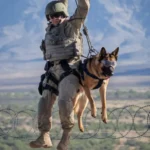Military working dogs, like their human counterparts, can suffer from post-traumatic stress disorder (PTSD) after returning from combat.

These brave canines serve alongside soldiers in high-stress environments, performing duties such as detecting explosives and patrolling dangerous areas.
When they return, many show signs of canine PTSD, a relatively new diagnosis that has started to gain recognition.
One such case is Balto, a Czechoslovakian shepherd who worked as a military dog for five years. Paired with handler John Logie, Balto served in Afghanistan, detecting explosive devices and assisting in high-risk missions.
Like many military dogs, he encountered intense combat situations that affected him deeply. After a traumatic incident involving an IED explosion, Balto began to show symptoms of PTSD, becoming overly sensitive to loud noises and gunpowder.
Experts estimate that 5-10% of military working dogs develop PTSD symptoms, which can include chronic anxiety, hypervigilance, and an avoidance of people or places.
Dr. Walt Burghardt, a veterinary behavioral specialist, explains that this is more common than many realize and affects more dogs than combat injuries or infectious diseases.
Recognizing these symptoms early is key to providing the necessary care and rehabilitation for these dogs.
For Balto, PTSD led to his early retirement in 2014, and Logie adopted him.
Despite being in a safer environment, Balto continued to exhibit signs of stress, especially around loud noises such as fireworks or thunderstorms. While treatment options, such as behavior modification and medication, helped manage his condition, Balto never fully recovered.
Veterinarians like Lori Teller emphasize the importance of creating a calm environment for dogs with PTSD and using techniques like desensitization to help them adapt. Though rehabilitation can take time, many dogs show improvement.
However, as Burghardt notes, with fewer military dogs being deployed to combat zones, the number of canine PTSD cases is expected to decline.
Contents
Conclusion
As the military continues to acknowledge the mental health needs of its working dogs, canine PTSD remains a challenge.
These loyal animals face extraordinary stress in combat, and their symptoms can last long after their missions are over.
While treatment options exist, it is crucial to continue improving awareness and support for these dogs who, like their human counterparts, deserve care and recognition for their service.
FAQs
- What is canine PTSD?
Canine PTSD is a condition where military working dogs show signs of anxiety, hypervigilance, and fear after experiencing traumatic events during combat. - How common is PTSD in military working dogs?
Experts estimate that 5-10% of military working dogs develop some form of PTSD, which is a significant number given the stress they endure in combat. - What are the symptoms of canine PTSD?
Common symptoms include chronic anxiety, restlessness, avoidance of certain people or places, and a heightened sensitivity to loud noises like fireworks or gunfire. - Can dogs with PTSD be treated?
Yes, dogs with PTSD can be treated using methods like behavior modification, desensitization, and medication, though full recovery may not always be possible. - How did Balto develop PTSD?
Balto, a military working dog in Afghanistan, developed PTSD after a traumatic experience involving an IED explosion that left his handler injured. - Is canine PTSD becoming more common?
While canine PTSD is a recognized condition, experts believe that as fewer military dogs are deployed to combat zones, the number of PTSD cases will likely decline in the future.








